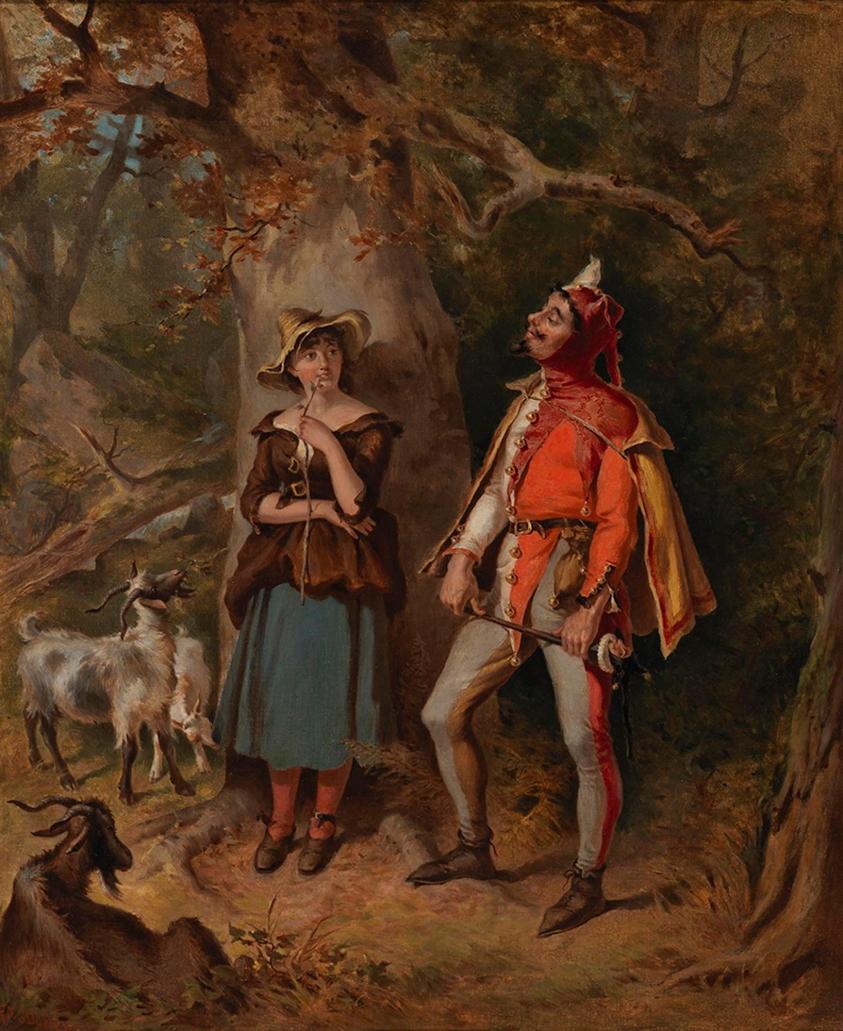
Artist:
Felix Octavius Carr Darley
(American, 1821 - 1888)
Touchstone and Audrey
Medium: Oil on canvas
Date: 1886
Dimensions:
27 1/8 × 22 1/8 in. (68.9 × 56.2 cm)
Accession number: 91.6.1
Label Copy:
Philadelphia-born F. O. C. Darley is considered the founder of American illustration for his thematic focus on American history and rural life and for his sophisticated artistic skill. His illustration career began with news journals and magazines and achieved notice through drawings for Edgar Allan Poe’s short stories.
He was recognized by his contemporaries for his humor and recreation of colorful characters, for the originality and theatrical quality of his compositions, and the elegance of his line. His classically inspired line drawings for Washington Irving’s Rip Van Winkle (1848), The Legend of Sleepy Hollow (1849), and Sylvester Judd’s Margaret (1856) offer romantic yet compelling views of American people and backwoods characters. Their publication by the American Art Union in large format gift books brought him national fame. The artist was renowned for his work in many American literary classics by James Fenimore Cooper, Nathaniel Hawthorne, and Henry Wadsworth Longfellow. Publications often included "illustrated by Darley" with their titles as a guarantee of artistic quality.
Touchstone and Audrey depicts characters from Shakespeare’s As You Like It. The painting is a variation of the artist’s earlier ink wash drawing (collection of the Folger Shakespeare Library) that appeared as a reproduction in Volume I of The Darley Gallery of Shakespearean Illustrations (1884). The painting was probably privately commissioned or painted for exhibition and sale.
Philadelphia-born F. O. C. Darley is considered the founder of American illustration for his thematic focus on American history and rural life and for his sophisticated artistic skill. His illustration career began with news journals and magazines and achieved notice through drawings for Edgar Allan Poe’s short stories.
He was recognized by his contemporaries for his humor and recreation of colorful characters, for the originality and theatrical quality of his compositions, and the elegance of his line. His classically inspired line drawings for Washington Irving’s Rip Van Winkle (1848), The Legend of Sleepy Hollow (1849), and Sylvester Judd’s Margaret (1856) offer romantic yet compelling views of American people and backwoods characters. Their publication by the American Art Union in large format gift books brought him national fame. The artist was renowned for his work in many American literary classics by James Fenimore Cooper, Nathaniel Hawthorne, and Henry Wadsworth Longfellow. Publications often included "illustrated by Darley" with their titles as a guarantee of artistic quality.
Touchstone and Audrey depicts characters from Shakespeare’s As You Like It. The painting is a variation of the artist’s earlier ink wash drawing (collection of the Folger Shakespeare Library) that appeared as a reproduction in Volume I of The Darley Gallery of Shakespearean Illustrations (1884). The painting was probably privately commissioned or painted for exhibition and sale.
Curatorial RemarksIt is not known why this work was created. It may have been privately commissioned or painted for exhibition. The painting is related to Darley's earlier illustration, "Touchstone and Audrey," which appears in Volume 1 of "The Darley Gallery of Shakespearean Illustrations" (1884). Darley's original illustrations for the publication were rendered in ink wash. The painting is a copy of the published work but lacks the figure in shadow on the right and the pair of goats on the far left. It also differs in details of clothing and in aspects of the woodland scenery.